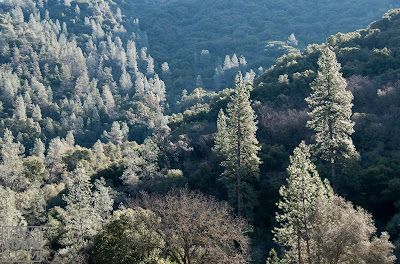January 28, 2012
6.3 Miles


This hike begins at the confluence of the North and Middle Forks of the American River, about four miles south of Auburn on Highway 49. When you get to the bridge just below the confluence, instead of taking a right turn and following Highway 49 across and up to Cool, continue straight toward Foresthill. In about a quarter of a mile you will see the kiosk and trailhead on the left, just before bridge over the North Fork (right center in the above Google Earth oblique). No doubt there will be several cars parked in the little lot there, regardless of the day of the week, but there is plenty of parking along the road shoulder.
I packed light on this outing - my Canon G12 in a
SnapR Bag. In a shirt pocket I carried a 52mm polarizing filter attached to a Lensmate quick change adaptor. With the adaptor the polarizer connects to the lens with a smooth bayonette twist and click when I want to darken the sky, remove the glare from water, or enrich the color of foliage. Or all three. Before clicking the shutter I rotate the filter for the best effect.
There were certainly plenty of cars parked at the trailhead by the time I got there, the first bright and sunny Saturday after a week or so of much-needed rain. I had to make my way between mountain bikers, hikers, dog walkers, and trail runners to read the maps and information display. Although the map did a lame job of guiding one to Clark's Hole, my first objective, it did provide some interesting history of the various bridges in the confluence area. One of the oldest was a covered toll bridge about a half mile up the North Fork on the stagecoach road from Auburn to Foresthill. Today the "new" Foresthill bridge looms about 700 feet above the old stone abutments.
 |
| Blackberry leaves along the North Fork |
My hike took me in that direction on my quest for "Clark's Hole". The goal was to explore a purported swimming hole in anticipation of summer outings with grandchildren. But I'd left it's trailguide at home in my haste to get going, and I gave up the attempt when the trail shown on the map at the kiosk ended in a patch of blackberry bushes. But the trail was easy after the first climb, the sun on my back felt good, and the air was filled with clean and moist smells from the recent rains.
I backtracked and headed up the Old Stagecoach Road. This trail is very wide, the road likely having been regraded to provide construction access to the west abutment of the new Foresthill Bridge. Good thing, because on the day of my walk it was crowded with other hikers, bikers, and equestrians. Nevertheless I was happy after some steady climbing to find an empty bench overlooking the Confluence.
 |
| Along the old Stagecoach Road, the new Foresthill Bridge in the background |
 |
| Looking down on the confluence area from Stagecoach Trail. The North Fork of the American River flows in from the left and beneath the "old" Foresthill bridge, the Middle Fork from the right, and together flow beneath the Highway 49 bridge in the foreground. |
 |
| Lunch stop along the Westtern States Trail |
After following the steady upward grade of the Stagecoach Trail (see the profile above), the loop route splits off onto the more level Manzanita Trail, which arrives after a mile of viewless travel through chaparral at the ASRA headquarters. I carefully dashed across busy Highway 49 to find Gate 136 leading to a steeply downward plunging fire road that took me to the Western States Trail. This popular trail provides some of the finest views along the river. It is also famed for the
Western States 100 Mile Endurance Run held in June, and the
Tevis Cup 100 Mile One Day Trail Ride held in August. Today it was busy with casual hikers like me, families with children clearly enjoying the day, and the occasional cyclist and equestrian.
 |
| An especially popular stop along the Western States Trail is this little waterfall and cool grotto |
This portion of the Western States Trail follows the grade of the Mountain Quarry Railroad. While the railroad is gone, the quarry still extract limestone from a deposit on the side valley of the Middle Fork Canyon a mile or so above the Highway 49 bridge. The deposit was originally exploited via a cave, in which were discovered Pleistocene mammal bones, including those of ground sloths and saber-toothed tigers, as well as human remains. These fossils help us imagine an environment in this area that is much different that today's.
 |
| The Mountain Quarry Railroad Bridge, also know as "No Hand's" Bridge was built in 1912 and carried limestone laden railcars into the 1940's |
A narrow footpath splits off to the left just before reaching the bridge. This trail climbs a bit then parallels Highway 49 back to the Confluence Area. From there I made my way along the road shoulder back to the car.
 |
| The Mountain Quarry Railroad Bridge |
 |
| Fern and 350 million year-old bedrock. 1/30 sec at f 3.5, ISO 100, with a polarizer to enhance the color of the fern. Processed in Lightroom 3 and Nik ColorEfex 4. |
 |
| A great day to try some gold-panning or simply rest in the sun |
 |
The trail provides views of gold panners and the sound of rushing water
(Photos taken with a Canon G12 and copyright Tony Mindling) |
 |
| Puzzling over the whereabouts of Clark's Hole. The mystery continues. |

























































